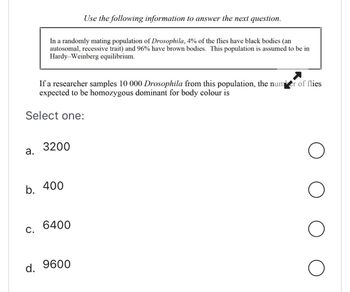
Human Anatomy & Physiology (11th Edition)
11th Edition
ISBN: 9780134580999
Author: Elaine N. Marieb, Katja N. Hoehn
Publisher: PEARSON
expand_more
expand_more
format_list_bulleted
Concept explainers
Question

Transcribed Image Text:The relationship between the barnacles and the whales is one of
Select one:
a.
b.
Use the following information to answer the next question.
Some grey whales have barnacles living on their backs. As the whales move from one
location to another, the barnacles are exposed to new sources of their food, plankton. Whales
are unaffected by the presence of the barnacles.
C.
Predation
Parasitism
Commensalism
d. Mutualism
O
O

Transcribed Image Text:If a researcher samples 10 000 Drosophila from this population, the number of flies
expected to be homozygous dominant for body colour is
Select one:
a.
Use the following information to answer the next question.
In a randomly mating population of Drosophila, 4% of the flies have black bodies (an
autosomal, recessive trait) and 96% have brown bodies. This population is assumed to be in
Hardy-Weinberg equilibrium.
C.
3200
b. 400
6400
d. 9600
O
Expert Solution
This question has been solved!
Explore an expertly crafted, step-by-step solution for a thorough understanding of key concepts.
Step by stepSolved in 2 steps

Knowledge Booster
Learn more about
Need a deep-dive on the concept behind this application? Look no further. Learn more about this topic, biology and related others by exploring similar questions and additional content below.Similar questions
- Give typing answer with explanation and conclusion Which of the following would NOT be considered an ecosystem service? A. Microbes in swamps decontaminate water B. Bats and pangolins are reservoirs for COVID-19 C. Wild Hazelnut trees have genetic diversity which is not found on farms, and which can be incorporated into the cultivated population to improve disease resistance when needed D. D. Spending time in nature benefits people suffering from depressionarrow_forwardDescribe and give an example of each of the following: a. Commensalism b. Mutualism c. Parasitismarrow_forwardIt is not always easy to categorize a particular case of symbiosis.Suppose a certain species of snail is always found living on a certain coral. No one has found evidence that the snail harms the coral, so the relationship is classified as an example of commensalism. How would you go about testing this hypothesis? What kinds of observations might lead to the conclusion that the snail is a parasite, or that it has a mutualistic relationship with the coral?arrow_forward
- Background: An area has two different Anopheles species, species A and species B. Both can vector Plasmodium, although Plasmodium develops best and is transmitted best by species B. Species A is dominant because its larvae outcompete species B in the main shared breeding sites, small lakes, and ponds. Therefore the population of B is currently small. The small lakes and ponds are also the source for the main food source in the region, fish, grown in fish farms. There is grazing land, but other than chickens, the local population does not have livestock. Species A is largely endophilic, species B is exophilic. In other localities, species A and B will also feed on cattle, and B appears to prefer cattle. Both species like to roost during the hot day in rock overhangs and small caves. Develop an alternative targeted strategy that might work well in this situation. Use only strategies that have been used successfully in the field and avoid "just spray everything" strategies. Explain why…arrow_forwardWhich statement about the classic competition experiments involving two Paramecium species is FALSE? The experiment involved interspecific competition. The experiment involved exploitation competition. Each species, when grown alone, exhibited logistic growth. When grown together, the species exhibited logistic growth, but each reached a lower carrying capacity than when it was grown alone.arrow_forward
arrow_back_ios
arrow_forward_ios
Recommended textbooks for you
 Human Anatomy & Physiology (11th Edition)BiologyISBN:9780134580999Author:Elaine N. Marieb, Katja N. HoehnPublisher:PEARSON
Human Anatomy & Physiology (11th Edition)BiologyISBN:9780134580999Author:Elaine N. Marieb, Katja N. HoehnPublisher:PEARSON Biology 2eBiologyISBN:9781947172517Author:Matthew Douglas, Jung Choi, Mary Ann ClarkPublisher:OpenStax
Biology 2eBiologyISBN:9781947172517Author:Matthew Douglas, Jung Choi, Mary Ann ClarkPublisher:OpenStax Anatomy & PhysiologyBiologyISBN:9781259398629Author:McKinley, Michael P., O'loughlin, Valerie Dean, Bidle, Theresa StouterPublisher:Mcgraw Hill Education,
Anatomy & PhysiologyBiologyISBN:9781259398629Author:McKinley, Michael P., O'loughlin, Valerie Dean, Bidle, Theresa StouterPublisher:Mcgraw Hill Education, Molecular Biology of the Cell (Sixth Edition)BiologyISBN:9780815344322Author:Bruce Alberts, Alexander D. Johnson, Julian Lewis, David Morgan, Martin Raff, Keith Roberts, Peter WalterPublisher:W. W. Norton & Company
Molecular Biology of the Cell (Sixth Edition)BiologyISBN:9780815344322Author:Bruce Alberts, Alexander D. Johnson, Julian Lewis, David Morgan, Martin Raff, Keith Roberts, Peter WalterPublisher:W. W. Norton & Company Laboratory Manual For Human Anatomy & PhysiologyBiologyISBN:9781260159363Author:Martin, Terry R., Prentice-craver, CynthiaPublisher:McGraw-Hill Publishing Co.
Laboratory Manual For Human Anatomy & PhysiologyBiologyISBN:9781260159363Author:Martin, Terry R., Prentice-craver, CynthiaPublisher:McGraw-Hill Publishing Co. Inquiry Into Life (16th Edition)BiologyISBN:9781260231700Author:Sylvia S. Mader, Michael WindelspechtPublisher:McGraw Hill Education
Inquiry Into Life (16th Edition)BiologyISBN:9781260231700Author:Sylvia S. Mader, Michael WindelspechtPublisher:McGraw Hill Education

Human Anatomy & Physiology (11th Edition)
Biology
ISBN:9780134580999
Author:Elaine N. Marieb, Katja N. Hoehn
Publisher:PEARSON

Biology 2e
Biology
ISBN:9781947172517
Author:Matthew Douglas, Jung Choi, Mary Ann Clark
Publisher:OpenStax

Anatomy & Physiology
Biology
ISBN:9781259398629
Author:McKinley, Michael P., O'loughlin, Valerie Dean, Bidle, Theresa Stouter
Publisher:Mcgraw Hill Education,

Molecular Biology of the Cell (Sixth Edition)
Biology
ISBN:9780815344322
Author:Bruce Alberts, Alexander D. Johnson, Julian Lewis, David Morgan, Martin Raff, Keith Roberts, Peter Walter
Publisher:W. W. Norton & Company

Laboratory Manual For Human Anatomy & Physiology
Biology
ISBN:9781260159363
Author:Martin, Terry R., Prentice-craver, Cynthia
Publisher:McGraw-Hill Publishing Co.

Inquiry Into Life (16th Edition)
Biology
ISBN:9781260231700
Author:Sylvia S. Mader, Michael Windelspecht
Publisher:McGraw Hill Education